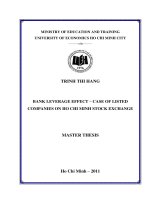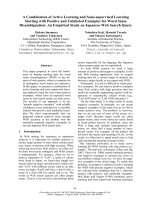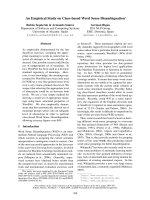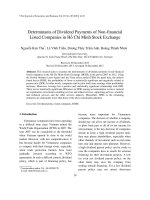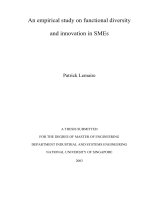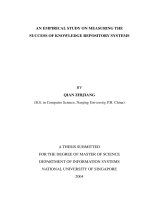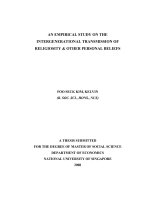An empirical study on company performance listed companies on ho chi minh stock exchange
Bạn đang xem bản rút gọn của tài liệu. Xem và tải ngay bản đầy đủ của tài liệu tại đây (811.89 KB, 76 trang )
CERTIFICATION
I hereby declare that the substance of this thesis is my own work and
knowledge. This dissertation has not been submitted for any other degree or
diploma of the university or higher degree. I certify that its contain has not been
published or written by another person.
CAO THI TUYET MAI
27 November 2012
i
ACKNOWLEDGEMENTS
During the time of studying in Vietnam – Netherlands programme for Master
of Arts in Developing Economics, I have learned so much useful knowledge.
Therefore, I would like to thank to Programme and all the teachers that have taught
me in this time.
I want to express my deepest gratitude to my academic supervisor, Dr.
Truong Tan Thanh, for his guidance and valuable comments in writing and
finishing my M.A. thesis. His enthusiastic and encouraging has supported me
during the process of this thesis to finish it on time.
Besides my supervisor, I want to acknowledge the tremendous support that I
received from Prof. Dr. Nguyen Trong Hoai – Dean of Vietnam – Netherlands
Programme and Dr. Pham Khanh Nam – Academic Director of Vietnam –
Netherlands Programme for their assistance and great encouragement.
I also would like to appreciate Master Nguyen Thanh Hai, Director of
Finance Advisory Department of Saigonbank Berjaya Securities Joint Stock
Company. His encourage and knowledge has supported me a lot during my thesis
writing process.
My grateful thanks to my friends, Nguyen Thi Tuyet Van and Phan Bui Gia
Thuy who help me overcome the difficulties to finish my thesis.
Last but not least, I am truly grateful to my family: my parents, my parents in
law, my husband and my brothers for their love and spiritual support in my life.
ii
ABSTRACT
The thesis determines which factors that affected the operations of the
companies listed on Ho Chi Minh Stock Exchange during the period 2007-2011 and
measures the level of the variables such as growth, leverage, leverage^2, risk, CEO
duality and size that impacted on performance of listed companies. It utilizes a
panel data of 93 Vietnamese listed companies and two methods accounting (ROA)
and market (Tobin’s Q) to estimate the performance of firms. It employs many
models in panel data such as Pool regression, Random Effects Model (REM) and
Fixed Effects Models (FEM) to control unobserved effects. Three kinds of models
are applied to find the most appropriate model and Fixed Effects Model is
considered the most suitable model for further discussions and recommendations.
The findings of this thesis show the support for not only the results of empirical
studies but also the trade off theory and stewardship theory. Size factor is the most
significant support for two metrics of firm performance ROA and Tobin’s Q at 1%
level. The thesis also finds that there is existence of the optimal capital structure
because of a non linear relationship between leverage and firm performance. In
particular, at 22.77% value of the optimal capital structure, the performance of firm
(measured by ROA) will get maximum value, or at 72.30% value of the optimal
capital structure, the performance of firm (measured by Tobin’s Q) will get
maximum value. Besides that, Growth and Risk are found to have effect at 1%
significant level to ROA only. Moreover, CEO duality just has effect to Tobin’s Q
at 1% level of significance. It is suitable in Vietnam condition because most of
firms in Vietnam are family firms, therefore, there always has a phenomenon one
person wears two hats. It leads the firm operate more efficiently and effectively
when the chairman serves as the CEO.
iii
TABLE OF CONTENTS
Certification
....................................................................................................... i
Acknowledgements ............................................................................................... ii
Abstract
..................................................................................................... iii
List of Tables .................................................................................................... vii
List of Figures ................................................................................................... viii
Abbreviations ..................................................................................................... ix
CHAPTER 1
INTRODUCTION ....................................................................... 1
1.1.
Problem statement ...................................................................................... 1
1.2.
Research questions ..................................................................................... 2
1.3.
Research rationale ...................................................................................... 2
1.4.
Research objectives .................................................................................... 3
1.5.
Research scope ........................................................................................... 3
1.6.
Structure of the research ............................................................................. 3
CHAPTER 2
2.1
LITERATURE REVIEW AND EMPIRICAL STUDIES ......... 4
Theoretical relation between firm performance, corporate governance and
capital structure .................................................................................................... 4
2.1.1
Firm performance ................................................................................ 4
2.1.2
M-M theory ......................................................................................... 5
2.1.3
Trade off theory ................................................................................... 6
2.1.4
Agency theory ..................................................................................... 8
2.1.5
Stewardship theory .............................................................................. 9
2.2
Empirical evidence ................................................................................... 10
iv
2.3
Corporate governance in Vietnam ............................................................ 14
2.4
Chapter remarks ....................................................................................... 16
CHAPTER 3
3.1
RESEARCH METHODOLOGY ............................................. 17
Variables .................................................................................................. 17
3.1.1
Dependent variable ............................................................................ 17
3.1.2
Explanatory variables ........................................................................ 18
3.2
The description of variables use in this research ....................................... 24
3.3
Estimation strategy ................................................................................... 25
3.4
Hypothesis statement and model specification .......................................... 25
3.4.1
Hypothesis ......................................................................................... 25
3.4.2
Specified model ................................................................................. 29
3.5
Data description ....................................................................................... 29
3.6
Chapter remarks ....................................................................................... 30
CHAPTER 4
EMPIRICAL ANALYSIS RESULTS ...................................... 31
4.1
The statistic descriptions of variables ....................................................... 31
4.2
The empirical analysis .............................................................................. 32
4.2.1 Correlation matrix .................................................................................... 32
4.2.2 Regression result ...................................................................................... 33
4.2.2.1Results of model robustness .................................................................... 33
4.2.2.2Analysis result ......................................................................................... 37
4.3
Conclusion ............................................................................................... 42
v
CHAPTER 5
SUMMARY AND RECOMMENDATION ............................. 43
5.1
Conclusion ............................................................................................... 43
5.2
Recommendations .................................................................................... 44
5.3
Limitations ............................................................................................... 45
REFERENCE ...................................................................................................... 47
APPENDIX I 93 LISTED FIRMS IN DATA SAMPLE ........................................ 51
APPENDIX II REGRESSION RESULTS ............................................................. 55
APPENDIX III GENERAL INFORMATION RELATED TO LISTED FIRMS .. 66
vi
LIST OF TABLES
Table 01 The description of variables use in the thesis .......................................... 24
Table 02 The descriptive statistics of data sample.................................................. 31
Table 03 The correlation matrix between ROA, TOBIN’s Q and variables ............ 33
Table 04 The White and Breusch-Godfrey test for Model 1A and 1B .................... 34
Table 05 The Hausman test for Model 2A and 2B ................................................. 34
Table 06 The Redundant Fixed Effects test for Model 3A and 3B ......................... 35
Table 07 The estimated coefficients of six regression models ................................ 36
Table 08 The Wald test for Model 3A and 3B ....................................................... 40
vii
LIST OF FIGURES
Figure 01. The optimal amount of debt and the value of firm ................................ 07
Figure 02. Number of listed firms in the period 2006-2012 .................................. 66
Figure 03. Number of new listed firms in the period 2006-2012 ........................... 66
Figure 04. Market Capitalization .......................................................................... 67
viii
ABBREVIATIONS
CEO ............................................. Chief Executive Officer
D/E ............................................... Debt to Equity
EBIT ............................................ Earnings before Interest and Tax
FEM ............................................. Fixed Effects Model
HOSE .......................................... Ho Chi Minh Stock Exchange
HNX............................................. Hanoi Stock Exchange
MBVE .......................................... Market Value of Equity and Book Value of
Liabilities Divided by Book Value of Equity
MBVR.......................................... Market Value of Equity to Book Value of Equity
MNC ............................................ Multinational Company
OLS .............................................. Ordinary Least Square
P/E ............................................... Price per Share to the Earnings per Share
PROF ........................................... Earnings before Interest and Tax plus
Depreciation to Total Assets
REM............................................. Random Effects Model
ROA ............................................. Return on Total Assets
ROE ............................................. Return on Equity
ROI .............................................. Return on Investment
SWOT .......................................... Strengths, Weaknesses, Opportunities and Treats
VND............................................. Viet Nam Dong
ix
CHAPTER 1
1.1.
INTRODUCTION
Problem statement
The stock market is an efficient channel for capital mobilization of the
economy in developed countries as well as developing countries, thus the birth of
the stock market in Vietnam plays a very important role in the attracting of domestic
capital, foreign capital and also the socio-economic development.
Founded on July 20, 2000 with two listed companies, however, over one
decade of operation at the end of 2011 there were 686 listed companies trading on
the Ho Chi Minh Stock Exchange (HOSE) and Hanoi Stock Exchange (HNX) with
capitalization reached 464,036 billion VND. To perform its role as a channel to
mobilize capital for economic efficiency, listed companies on the stock market
themselves have to operate efficiently in order to create the trustworthiness from
shareholders as well as domestic and foreign investors. Therefore, the performance
of listed companies plays an important role to keep the market stabilizing and
developing.
Determining which variables impacted on and how they affected to the
performance of listed enterprises is important because they will help not only the
investors make right investing decisions but also the managers can know the
variables that have more significant influence on firm to manage more efficiently
and moreover, company can operate more effectively.
Currently, most research in Vietnam concentrates on issues affecting of the
macro variables to the performance of the company therefore it has very little
research on the internal matters of business. In contrast, this thesis only focuses on
the internal matters of the business such as corporate governance, debt ratio, growth
rate, capitalization, risk and also corporate sectors. This means the research subject:
1
"An empirical study on company performance: Companies listed on Ho Chi Minh
stock exchange" is essential.
1.2.
Research questions
The questions of the thesis focus on identifying the factors that affected the
performance of listed companies. Specifically, this research will answer the
following questions:
1) Which variables that affected the performance of listed companies in Ho
Chi Minh Stock Exchanges?
2) How did they affect to the firms performance?
1.3.
Research rationale
In Vietnam, there were some researches that studied the effect of internal
factors to the performance of firms such as Cuong Nguyen and Canh Nguyen
(2012), Son Tran and Hoang Tran (2008), Oanh Nguyen (2010) and Son Nguyen
(2010). However, these researches just used accounting method to measure the firm
performance like Cuong Nguyen and Canh Nguyen - ROE, Oanh Nguyen - ROA
and Son Tran and Hoang Tran – ROA and ROE. Besides that, the data was collected
up to year 2010 (Oanh Nguyen), year 2008 (Son Tran and Hoang Tran). Therefore,
this thesis will extend more researches that study about the impact of internal factors
on firm performance using market and accounting methods and the data will be
updated to year 2011. Besides that, this thesis can be considered the empirical study
on examining the corporate governance and the trade off theory. In reality, it will
help the firms not only in their corporate governance but also in debt financing.
Moreover, the thesis will also assist the investors and creditors in making their
investment decisions. The creditors can lend their money to the healthy firm and the
2
investors can invest in the good performance firm. Finally, firms may choose
appropriate optimal capital structure given firm conditions.
1.4.
Research objectives
The research objective of this thesis is to determine the factors affecting the
performance of companies listed on Ho Chi Minh Stock Exchange during the period
2007-2011. Besides, this thesis also measures the impacts of factors on the firm
performance. The results may have implications for managers and researchers.
1.5.
Research scope
The research carries out a study of a number of internal factors of 93 listed
companies on Ho Chi Minh Stock Exchange (HOSE) that were affecting the
performance of these companies during the period 2007-2011. Based on the
analysis, we will look at the extent to which they may affect the firm performance.
We use both accounting (ROA) and market measure (Tobin's Q) as proxies for the
firm performance.
The data of 93 listed companies in HOSE is collected in the period 20072011, excluding finance firms (bank, securities, investment funds and insurance)
because of their specific performance.
1.6.
Structure of the research
There are five chapters in this research. Chapter 1 talks about the structure
and objectives of the thesis. Chapter 2 introduces the theoretical basis and the
previous studies. Chapter 3 describes the data, the method used in this research and
presents analysis estimate of the model. Chapter 4 presents and discusses research
results. Chapter 5 summarizes the research results and concludes with some
recommendations and limitations.
3
CHAPTER 2
LITERATURE REVIEW AND EMPIRICAL STUDIES
This chapter mainly discusses about four theories and some empirical studies
that relate to firm performance. Besides that, corporate governance in Vietnam is
also mentioned in this chapter. The chapter is divided into three parts. The first part
contains the concept of firm performance and five theories that are used in this
thesis. The next part provides some empirical studies which support for this thesis.
The final part discusses about the corporate governance in Vietnam.
2.1
Theoretical relation between firm performance, corporate governance
and capital structure
2.1.1
Firm performance
According to Draf (2007), the performance of the company related to the way
of using resources in an efficient way to reach the targets. Efficient performance of
the company was identified and measured by various criteria such as return on asset
(ROA), return on equity (ROE), and return on Investment (ROI). These criteria
were considered the accounting point of view to approach the efficient operations of
the company. There was also a market perspective to determine the effectiveness of
business performance through criteria such as Price to Earnings per Share (P/E),
Tobin's Q, market value of equity to book value of equity and free cash flow per
share.
In Topak’s study (2011), there were many ways to measure business
performance using indicators such as ROA, ROE; these indicators were also used by
many authors such as Gill, A. and Mathur, N. (2011), Erhardt et al. (2003), Carter
D., A. et al (2003), and Bhagat S. and Black B. (2002). Bathula H. (2008) also used
the ROA and Tobin's Q to measure firm performance. Besides that, Boyd (1995)
used the return on investment (ROI) to determine the performance of 192 companies
in America.
4
Moreover, the performance of the company was also measured base on
accounting and market methods by Zeitun and Tian (2007). The indicators were
used in accounting methods, including ROA, ROE, PROF (Earnings before tax and
interest plus depreciation to total asset). In market method, Zeitun and Tian (2007)
estimated the performance of company by some tools such as Tobin's Q index, P/E,
market value of equity to book value of equity (MBVR) and market value of equity
plus book value of debt to book value of equity (MBVE).
Depend on the purpose of authors’ study; there are many methods that are
used to evaluate the performance of the company. However, this research will use
two indicators ROA - accounting method and Tobin's Q - market method to assess
the performance of listed companies on Ho Chi Minh Stock Exchange.
2.1.2 M-M theory
Modigliani and Miller theory mentions the relationships between firm value,
cost of capital and leverage. M&M theory assumes that the capital market is perfect
so that there are no financial distress cost, no transaction cost and no bankruptcy
cost. Modigliani and Miller consider those relationships in two propositions with
two conditions – tax and no tax.
In the case without tax, the value of levered firm and the value of unlevered
firm are equivalent as follow:
V L = VU
VL: is the value of firm using debt.
VU: is the value of firm using no debt.
In this situation, the value of the firms is the same under the difference of
leverage. Therefore, the firm cannot increase its value by changing the capital
structure. In other words, the changing in capital structure does not make any
benefit to shareholders.
In the case of having tax, the value of firm with debt is equal the value of
firm with no debt plus tax shields.
5
VL = VU + T*D
T: is the corporate income tax
D: is debt
This means the value of firm will be raised by using debt and the company
should be better to increase debt to equity ratio. This result is the famous M&M
proposition I.
M&M proposition II studies whether there is the impact of changing in
capital structure on the average cost of capital and concludes that the weighted
average cost of capital will decrease when the cost of equity increases with leverage.
However, M&M theory does not consider the impact of some other costs
such as financial distress cost that makes the benefit of tax shield be reduced and
cancelled when the company increases the debt ratio. At that time, the financial
distress cost will be larger than the tax shield and it cancels the optimal capital
structure (this is the point that the value of firm will be maximized while the
weighted average cost of capital minimized). When the capital structure is greater
than the optimal level, the value of company will be decreased while the weighted
average cost of capital will be gone up and the benefit of tax shield is not large
enough to offset the financial distress cost. This makes the company may be in weak
financial situation, reducing the liquidity and payment ability.
2.1.3 Trade off theory
Modigliani and Miller states that the value of firm will be maximized at 100
percent of debt in the presence of corporate taxes. It means that all the companies
will choose maximize debt. However, in the real world the firms have the target
debt ratio; the reason here is because there is not only the benefit from tax shield but
also the cost of potential bankruptcy. This is the trade – off theory of leverage that
the debt ratio of the firm depends on the trade – off between the tax benefits of debt
and the cost of debt. Thus, the companies should have the optimal capital structure
to maximize their benefit from tax shield and minimize their bankruptcy cost.
6
VL = VU + TCB = Value of
firm under MM with
corporate taxes and debt
Value of firm
The present value
of taxshield on
Present value of financial
distress costs
Maximum
firm value
V = Actual value of firm
VU = Value of firm
with no debt
B*
Optimal amount of debt
Debt
Figure 01 The optimal amount of debt and the value of the firm
Source: Ross et al. (2005), page 443, chapter 16, figure 16.1: the optimal amount of Debt and the Value of the
firm.
The Figure 01 above shows the trade – off theory between benefit of tax
shield and the cost of financial distress. When the firm tries to raise the number of
debt, the benefit of the firm is the present value of tax shield on debt and the
financial distress cost is still lower than the benefit of tax shield. Therefore, the
value of the firm will be increased in this case. Nevertheless, since more and more
debt is used, the cost of financial distress will grow. Point B*, this is the optimal
level of debt that the value of the firm will be maximized. Therefore, from this point
if debt is increased, the financial distress cost will reduce and offset the benefit of
tax shield.
However, in practice it is very difficult to measure the financial distress cost.
The financial distress cost could be the legal cost such as the cost for the lawyer
who makes document for bankruptcy process, accounting cost in this process or the
cost of losing key staff (will jump to another organization), suppliers (will reject to
give credit), customers (will look for another stable suppliers) and the lenders (give
7
the restrictive loans and higher interest). Although, these expenses are very hard to
specify, they can explain why the firm does not want to raise the debt ratio to 100
percent in reality.
2.1.4 Agency theory
According to Jensen and Meckling (1976), there was the relationship
between
capital
owners
(shareholders)
and
human
capital
management
(managers/agents) in an enterprise. The owner hired employers on their behalf to
manage and make decisions in the administration of daily business. The capital
owners were interested in the value of the enterprise, while the manager did not
concern to the company value, they just cared their interests such as salary, bonuses,
allowances and other income they got from their position. Therefore, the agency of
the company did not manage the company for the benefit of the owners (Eisenhardt,
1989).
Base on Jensen and Meckling study (1976), there were two types of conflict:
conflict between owners and managers and the conflict between owners and
creditors. Conflict between owners and managers occurred because of the separation
between management and ownership in the modern business model. When
dispersed ownership appeared, the shareholders lacked power to monitor manager's
actions. Therefore, the managers had opportunity to make their own benefit and this
led badly effect to the interests of shareholders.
Besides that, conflict between owners and creditors happened when the
company loaned. Creditors lent the shareholders of a company via the managers on
their behalf to invest in the project and made benefit for both parties. The creditor
would depend on the level of project risk, collateral, and debt ratio of enterprises as
well as results of production and performance to lend their money to get income
from interest. As the shareholders, they desired the managers to implement the
projects with higher risk levels because of the higher level of risk, the higher of
8
profits. If high-risk project was successful, the owners would get all of this profit,
and the creditors should remain the fixed profit from the accrued interest. However,
in the case of this high-risk projects failed, the creditors might have the losses from
the delayed recovery of principal and interest or potentially lost the loan amount.
With such risks, the lender could request to participate in monitoring the project
disbursement. This was considered the agency cost that the owner had to pay to use
the loans from their creditors.
There were many ways to control the agency costs such as increasing the
control, internal audit, obligation and authority of the management board. Besides
that, Jensen and Meckling (1976) recommended that used the financial leverage to
reduce conflict between managers and owners, as well as the establishment of good
relations between owner and their representatives through their salary according to
what they presented (Fama and Jensen, 1983).
2.1.5
Stewardship theory
The agency theory assumes that human tends to individual, opportunity and
self-interest, while Davis, J., H. et al. (1997) suggested that it had better to have
another point of view about managers.
The manager had their own motivation and needs to promote such as pride to
improve their position, increasing confidence and also recognizing from colleagues
and senior management (Donaldson, L., 1990). According to Stewardship theory,
the performance of the company has directly related to CEO because they are the
person who understand the business clearly and will make the best decisions for the
company. With the idea of stewardship theory, these managers are reliable and will
minimize the cost.
9
2.2
Empirical evidence
In these days, there are many researches that study on the performance of
companies through some variables such as leverage, corporate governance, firm
growth, firm size, risk, industrial sectors and so on in both developed and
developing countries. In particular, this thesis will look at a few researches as
below.
Coleman and Biekpe (2006) examined the relationship between some
measurements of corporate governance such as board size, board composition and
CEO duality and firm performance like ROA, Tobin’s Q and Growth in sales in
Ghana. It used the data of 16 listed non-financial firms on Ghana Stock Exchange
during the period 1999 – 2001. The results showed that the board size positively
related to ROA and Tobin’s Q, but it had the negative relationship to growth in
sales. The results also found that board composition had a negative relationship to
firm performance and CEO duality influenced positively and insignificantly to the
listed firm performance (ROA) in Ghana, however, it had a negative and significant
impact on Tobin’s Q.
Zeitun and Tian (2007) proposed research model on the performance of 167
companies in Jordan during the period 1989-2003, as below:
Yit = β0 – β1Lerverageit + β2Growthit + β3Sizeit + β4 STDVCFit + β5TAXit +
β6Tangibilityit + PoliticalCrisisit + INDUSTit + µ i + uit
Yit was the efficient performance of the company, measured by several
variables such as ROA, Tobin's Q, ROE, P/E, MBVE and MBVR. However, Zeitun
and Tian only found that ROA and Tobin's Q were the most powerful in Jordan to
measure the performance of firm. In detail, they used Random Effects model to test
the impact of capital structure on firm performance. They concluded that capital
structure had the significant and negative impact on the firm performance measured
in both the market and accounting methods. This study also implied that, high
performance was associated with a high tax rate. The results also showed that firm
10
size had a positive relationship with firm performance because large firms had low
bankruptcy costs.
Furthermore, from 2004 to 2007 Bathula H. (2008) used the sample of 156
firms to test the relationship between board characteristics and New Zealand firm
performance. The research used the Generalized Least Squares analysis and showed
that board characteristics such as board size, CEO duality and gender diversity had
the positive relationship to firm performance, while director ownership, board
meetings and the number of board members with PhD level education had the
negative relationship.
Another research of Son Tran and Hoang Tran (2008) studied about the
capital structure and firm performance listed on Ho Chi Minh stock exchange,
which used 50 non-financial listed firms and the variables such as D/E, D/E2, D/E3,
growth, size and tangible asset. It proved that the firm performance had the negative
relationship with leverage when D/E ratio was larger than 1.812. In contrast, it had
the positive relationship when D/E ratio was smaller than 1.812. The mean of D/E
of listed firms were 0.9286 lower than 1.812, therefore firm performance had the
positive relationship with leverage and firms could increase the debt ratio to raise
the firm value.
Besides that, Chou and Lee (2010) researched the effects of capital structure
on the performance of 37 non-financial companies listed in the Taiwan 50 and 89
non- financial firms listed in the Taiwan Mid – Cap 100 from 1987 to 2007; he
recommended a model to exam the impact of leverage to ROE as follow:
V = α + β Debt + γ Debt2
V was denoted ROE while Debt was considered leverage. This model was
used to examine the hypothesis that leverage had the non linear relationship with
firm performance. To rely on the M-M theory and trade off theory, the researchers
expected that when the firm increased the leverage, it would improve the firm value.
Nonetheless, if the firm increased the leverage to the fixed level, it would make the
firm lose the payment ability and delete the advantage of tax shield from debt. He
11
demonstrated that there was a significant and negative effect of debt ratio to the firm
performance. The regression result also showed that the optimal capital structure of
firms listed in Taiwan 50 was 34.31%, and the optimal debt ratio of the firms listed
in Taiwan 100 was 34.64%. This explained the financial distress cost would be
offset the benefit of tax shield when the firm tried to increase the leverage.
The research of Gill, A. and Mathur, N. (2011) analyzed the effect of board
size and CEO duality to the value of 91 Canadian manufacturing firms that were
listed on Toronto Stock Exchange during 2008-2010. The results indicated that the
firm with larger board size (large number of directors) had a negative impact on its
value while CEO duality has a positive impact on firm performance.
Moreover, Rouf M., A. (2011) used the data of 93 listed non-financial firms
on Dhaka Stock Exchange in 2006 to investigate the relationship between four
corporate governance mechanisms (board size, board independent director, CEO
duality and board audit committee) and firm performance (measured by ROE and
ROA). He used the OLS as a method of estimation to prove the result that there was
a positive and significant relationship between ROA and board independent director
as well as CEO duality. The result was also the same with ROE, however there were
insignificant relationships between firm performance (measured by ROA and ROE)
and board size and also board audit committee.
The recent research of Cuong Nguyen and Canh Nguyen (2012) studied
about the effect of capital structure on 92 Vietnam’s seafood processing enterprises
from 2005 to 2010 and found that the firm value had a non linear relationship with
financial leverage. It meant that the value of Vietnam’s Seafood processing firm
would be improved if the debt ratio was less than 59.27%.
Regards to Rouf M., A. (2011), corporate governance was the set of rules,
policies, law and processes to control and administer the way that firm operated. It
not only included the relationship between the principal and their agents, but also
controlled the firms operation to achieve the goals and made sure the firms
resources were managed and used efficiently (Mutairi and Hasan, 2010).
12
Corporate governance was also the relationship between firm managers and
the equity providers - the person that invested their money and earned income. The
literature on corporate governance suggested that all the stakeholders like managers,
directors, suppliers, employees, customers and creditors were playing important role
in improving the firm value (Rouf M., A. 2011). The firm with good corporate
governance would increase the investors trust. It was proved by Jesen and Meckling
(1976), the good governed firms might operate efficiently and therefore they would
have a better future cash flow.
This thesis focuses on the key characteristic of corporate governance,
specially the CEO duality. It means that the chairman of the board directors also
serves as the CEO of the firm. According to Fama and Jensen (1983), CEO duality
would reduce the firm performance and also decreased the role of board directors in
controlling the managers. There was a conflict of interest and would increase the
agent cost when one person occupied the two positions. Furthermore, the firm
should not let the duality happen (Brickley et al., 1997). Yermack (1996) and Sanda
et al. (2005) also suggested that the firm would operate more effective if the
chairman of board directors was different from the chief executive officer. Rouf M.,
A. (2011) had the same point of view with Yermack and Sanda et al., on his study
about 93 companies in Bangladesh in 2006 that there had the positive relationship
with ROE when the chairman of the board of directors and the CEO were occupied
by two persons.
In contrast, many researchers found that CEO duality had the positive
relationship to firm performance. For example, according to Gill, A. and Mathur, N.
(2011), CEO duality was positive and significant relationship to the performance of
manufacturing firm in Canada and the firm value could be improved by CEO
duality. Besides that, there were some results that were not consistent with the
previous researches such as Baliga et al., (1996) proved that there was very little
evidence for the relationship between CEO duality and firm performance. Similarly,
Chen et al., (2008) researched the enterprises in Compusat from 1999 to 2003 and
13
concluded there was no statistical significance relationship between CEO duality
and firm performance. Moreover, Markus and Henz, (2007) studied on 152 Swiss
firms with daily data from 2000 to 2002 and claimed that there was no important
evidence in different value between the companies which had the duality and non
duality.
In all studies above, the researchers had investigated the relationship between
the performance of enterprises and independent variables. The variables in the
previous researches were used to explain the impact on firms’ performance that
included firm size, tax, capital structure, board size, CEO duality, gender diversity,
director ownership, board meeting and so on. These variables had been tested in
several studies of previous authors who found the important results about the impact
of these variables on the performance of the companies. Depend on the previous
study as well as the difficulties in collecting data for the study, the variables are
selected, including CEO duality, leverage, leverage^2, firm risk, growth and firm
size to test whether or not affected to the performance of 93 listed firms on Ho Chi
Minh Stock Exchange from 2007 to 2011 and how they impacted on the
performance of these firms.
2.3
Corporate governance in Vietnam
On 13/03/2007, the Ministry of Finance of Vietnam issued Decision No.
12/2007/QD-BTC of corporate governance that was applied to listed companies on
the Stock Exchange. The decision was issued based on Law No. 60 of 2005
Business Securities Law No. 70 of 2006 and the best international practices of
corporate governance in accordance with the conditions and regulations of Vietnam.
Regulations presented the principles of corporate governance to ensure that
the interests of shareholders and provided behavioral standards and ethics of the
Board of Directors, Supervisory Board and the managers of listed companies. These
were also the basis for evaluating the corporate governance of listed companies.
14
Corporate governance Decision 12/2007/QD-BTC is defined as follows:
Corporate governance is the system of rules to ensure that the company is managed
and operated so that it will make benefits for the shareholders and related people. It
includes the following rules:
-
Ensure effective governance structure,
-
Ensure the rights of shareholders,
-
Ensure fairly treatment between shareholders,
-
Ensure the role of relevant beneficiaries,
-
Ensure transparency in the operations of the company,
-
Ensure the Board and the Supervisory Board work effectively and
efficiently.
The main principles of corporate governance in the decision of 12/2007/QDBTC for listed companies, including:
-
Rights of shareholders
-
General Meeting of Shareholders
-
Board of Directors
-
Board of Supervisors
-
Conflict of interest and transactions with related parties
-
Information disclosure and transparency
With the rules as above, it aims not only to protect the right of shareholders
and related partners, but also makes sure that the company operates clearly and
effectively.
In Article 10, this Decision shows clearly that the Chairman of the Board of
Directors cannot concurrently hold the position of Director or Chief Executive
Officer, unless this is approved by shareholders at the annual general meeting. In
reality, according to this data sample, there was about 42% in 93 companies listed
on HOSE that had the duality. According to Son Nguyen (2010), there was over
60% in 400 companies in Vietnam that the Chairman also served as the CEO.
Therefore, there was no separation of the roles between corporate supervision and
15
corporate execution and most of firms lacked long-term developing strategy. In the
condition of Vietnam, it is clear that the Chairman serves as the CEO because most
of firms are small and family companies at the beginning of establishment. When
they become the public companies, the business owners do not want to lose the role
of management and they still hold a large number of stocks; therefore, they always
wear two hats.
In addition, in the research about corporate governance of listed companies in
Vietnam 2008, Toan, L., M. and Walker G. found that although companies had the
specific rules of corporate governance, they were still in the beginning of
development process and needed to be reformed. The listed companies had to
improve in corporate governance to make sure that the stock market operated
transparently, protected the investors and the management was efficient.
In these days, Vietnamese firms have recognized the important role of
corporate governance because if they have well corporate governance, they will
enhance the trust of the shareholders, the investors, the creditors and they can
approach to the capital inflow from the foreign investors. Therefore, it is obvious
that they need to improve the quality of corporate governance when they join the
international business environment.
2.4
Chapter remarks
This chapter mainly discusses about four theories: M-M theory, trade-off theory,
agency theory and stewardship theory. Besides that, some empirical studies related
to firm performance that is mentioned in this chapter. Moreover, corporate
governance in Vietnam is also discussed in this part. In these days, Vietnamese
enterprises have recognized the important role of corporate governance and they
always try to improve the quality of corporate governance to get the best
performance when they join the international business environment.
16
